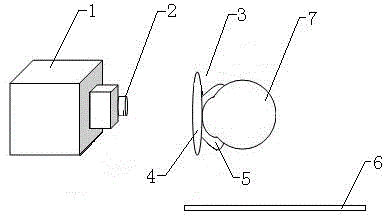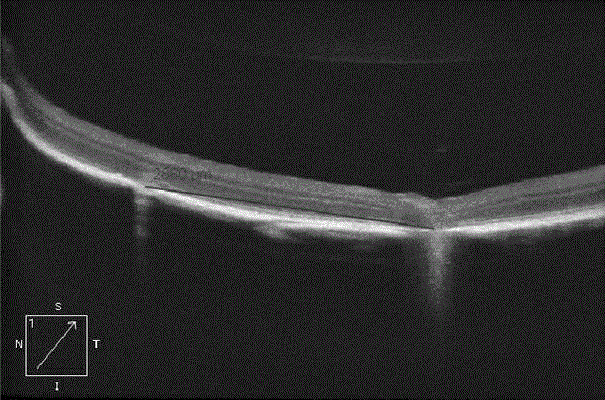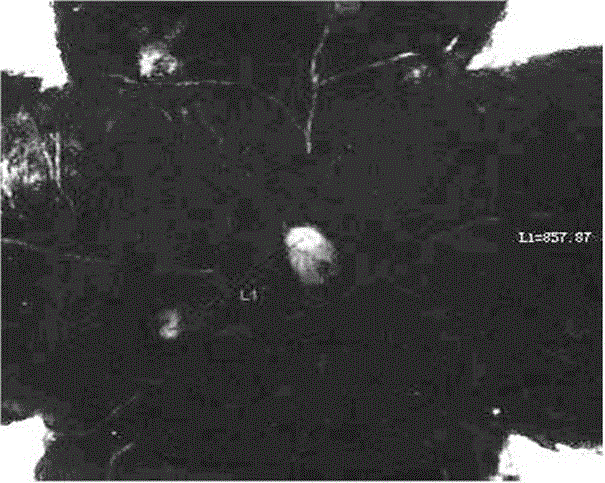A method for measuring multi-parameters of living mouse retina
A mouse retina and multi-parameter technology, applied in the fields of eye testing equipment, medical science, ophthalmoscope, etc., can solve the problems of slice omission, waste of funds, unfavorable animal protection, etc., and achieve accurate results, good repeatability, and easy Positioning and Quantitative Checks for Effects
- Summary
- Abstract
- Description
- Claims
- Application Information
AI Technical Summary
Problems solved by technology
Method used
Image
Examples
Embodiment 1
[0038] C57BL mice were selected, and attention was paid to check whether the refractive medium of the mice was transparent before the examination; at the same time, the most common clinical OCT instrument 1: Zeiss Cirrus HD-OCT 4000 or 400 was used. The anesthesia made of a mixed solution of ketamine and xylazine was injected intraperitoneally at 0.2ml / 20g body weight to anesthetize the mice. After the anesthesia was successful, laser photocoagulation was performed on the fundus of the mice, and a laser spot (diameter 50 μm) was formed at a random position on the mouse retina. , breakdown Bruch membrane). Then the mice were fixed on the three-dimensional experimental table 6; then the pupils of the mice were dilated with the mydriatic agent made of compound tropicamide diluted in normal saline, and the medical hyaluronic acid viscoelastic agent (as the concave lens 5) was covered on the On the surface of the mouse eyeball 7, take the cover glass 4 and place it on the hyaluroni...
Embodiment 2
[0043] C57BL mice were selected, and attention was paid to check whether the refractive medium of the mice was transparent before the examination; at the same time, the most common clinical OCT instrument 1: Zeiss Cirrus HD-OCT 4000 or 400 was used. Anesthesia made from a mixed solution of ketamine and xylazine was injected intraperitoneally at 0.2ml / 20g body weight to anesthetize the mice. After the anesthesia was successful, the mice were fixed on the three-dimensional experimental platform 6; After dilating the pupils of mice with a mydriatic agent made of amine, the medical hyaluronic acid viscoelastic agent (as a concave lens 5) was covered on the surface of the mouse eyeball 7, and the cover glass 4 was placed on the hyaluronic acid viscoelastic agent to form a small The plano-concave lens 3 on the front surface of the mouse eyeball 7; a Volk Superfield NC front lens 2 with a diopter of 90D is fixedly arranged in front of the lens of the OCT instrument 1, and the three-di...
Embodiment 3
[0049] C57BL mice were selected, and attention was paid to check whether the refractive medium of the mice was transparent before the examination; at the same time, the most common clinical OCT instrument 1: Zeiss Cirrus HD-OCT 4000 or 400 was used. Anesthesia made from a mixed solution of ketamine and xylazine was injected intraperitoneally at 0.2ml / 20g body weight to anesthetize the mice. After the anesthesia was successful, the mice were fixed on the three-dimensional experimental platform 6; After dilating the pupils of mice with a mydriatic agent made of amine, the medical hyaluronic acid viscoelastic agent (as a concave lens 5) was covered on the surface of the mouse eyeball 7, and the cover glass 4 was placed on the hyaluronic acid viscoelastic agent to form a small The plano-concave lens 3 on the front surface of the mouse eyeball 7; a Volk Superfield NC front lens 2 with a diopter of 90D is fixedly arranged in front of the lens of the OCT instrument 1, and the three-di...
PUM
 Login to View More
Login to View More Abstract
Description
Claims
Application Information
 Login to View More
Login to View More - R&D
- Intellectual Property
- Life Sciences
- Materials
- Tech Scout
- Unparalleled Data Quality
- Higher Quality Content
- 60% Fewer Hallucinations
Browse by: Latest US Patents, China's latest patents, Technical Efficacy Thesaurus, Application Domain, Technology Topic, Popular Technical Reports.
© 2025 PatSnap. All rights reserved.Legal|Privacy policy|Modern Slavery Act Transparency Statement|Sitemap|About US| Contact US: help@patsnap.com



